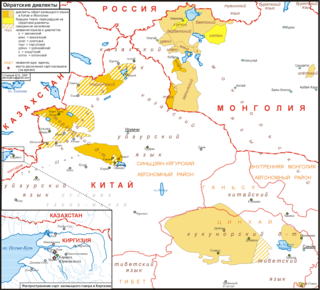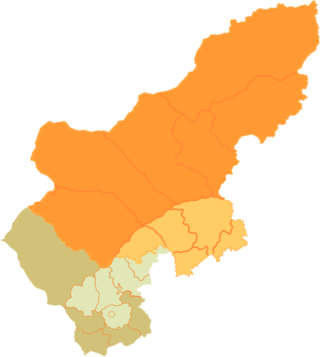
Outer Mongolia was the name of a territory in the Manchu-led Qing dynasty of China from 1691 to 1911. It corresponds to the modern-day independent state of Mongolia and the Russian republic of Tuva. The historical region gained de facto independence from Qing China during the Xinhai Revolution.

Mongolian is the principal language of the Mongolic language family that originated in the Mongolian Plateau. It is spoken by ethnic Mongols and other closely related Mongolic peoples who are native to modern Mongolia and surrounding parts of East and North Asia. Mongolian is the official language of Mongolia and Inner Mongolia and a recognized language of Xinjiang and Qinghai.

The Mongolic languages are a language family spoken by the Mongolic peoples in Eastern Europe, Central Asia, North Asia and East Asia, mostly in Mongolia and surrounding areas and in Kalmykia and Buryatia. The best-known member of this language family, Mongolian, is the primary language of most of the residents of Mongolia and the Mongol residents of Inner Mongolia, with an estimated 5.7+ million speakers.

Tuvan or Tyvan is a Turkic language spoken in the Republic of Tuva in South Central Siberia, Russia. The language has borrowed a great number of roots from the Mongolian language, Tibetan and the Russian languages. There are small diaspora groups of Tuvan people that speak distinct dialects of Tuvan in China and Mongolia.
Evenkiay-VEN-kee (Ewenkī), formerly known as Tungus or Solon, is the largest member of the northern group of Tungusic languages, a group which also includes Even, Negidal, and the more closely related Oroqen language. The name is sometimes wrongly given as "Evenks". It is spoken by Evenks or Ewenkī(s) in Russia and China.

Oirat is a Mongolic language spoken by the descendants of Oirat Mongols, now forming parts of Mongols in China, Kalmyks in Russia and Mongolians. Largely mutually intelligible to other core Central Mongolic languages, scholars differ as to whether they regard Oirat as a distinct language or a major dialect of the Mongolian language. Oirat-speaking areas are scattered across the far west of Mongolia, the northwest of China and Russia's Caspian coast, where its major variety is Kalmyk. In China, it is spoken mainly in Xinjiang, but also among the Deed Mongol of Qinghai and Subei County in Gansu.
The Khalkha dialect is a dialect of central Mongolic widely spoken in Mongolia. According to some classifications, the Khalkha dialect includes Southern Mongolian varieties such as Shiliin gol, Ulaanchab and Sönid. As it was the basis for the Cyrillic orthography of Mongolian, it is de facto the national language of Mongolia. The name of the dialect is related to the name of the Khalkha Mongols and the Khalkha river.

The traditional Mongolian script, also known as the Hudum Mongol bichig, was the first writing system created specifically for the Mongolian language, and was the most widespread until the introduction of Cyrillic in 1946. It is traditionally written in vertical lines Top-Down, right across the page. Derived from the Old Uyghur alphabet, it is a true alphabet, with separate letters for consonants and vowels. It has been adapted for such languages as Oirat and Manchu. Alphabets based on this classical vertical script continue to be used in Mongolia and Inner Mongolia to write Mongolian, Xibe and, experimentally, Evenki.
The Dagur, Daghur, Dahur, or Daur language, is a Mongolic language, as well as a distinct branch of the Mongolic language family, and is primarily spoken by members of the Dagur ethnic group.
Middle Mongol or Middle Mongolian was a Mongolic koiné language spoken in the Mongol Empire. Originating from Genghis Khan's home region of Northeastern Mongolia, it diversified into several Mongolic languages after the collapse of the empire. In comparison to Modern Mongolian, it is known to have had no long vowels, different vowel harmony and verbal systems and a slightly different case system.
Torgut, also spelled Torghud, is a dialect of the Oirat language spoken in Xinjiang, in western Mongolia and in eastern Kalmykia. Thus, it has more speakers than any other variety of Oirat. It is better researched than any other Oirat variety spoken in China.
Ordos Mongolian is a variety of Central Mongolic spoken in the Ordos City region in Inner Mongolia and historically by Ordos Mongols. It is alternatively classified as a language within the Mongolic language family or as a dialect of the standard Mongolian language. Due to the research of Antoine Mostaert, the development of this dialect can be traced back 100 years.
The Khorchin dialect is a variety of Mongolian spoken in the east of Inner Mongolia, namely in Hinggan League, in the north, north-east and east of Hinggan and in all but the south of the Tongliao region. There were 2.08 million Khorchin Mongols in China in 2000, so the Khorchin dialect may well have more than one million speakers, making it the largest dialect of Inner Mongolia.
Alasha, or Alaša-Eǰen-e, is a Mongolic variety with features of both Oirat and Mongolian that historically used to belong to Oirat but has come under the influence of Mongolian proper. It has more than 40,000 speakers in Alxa League, Inner Mongolia, China and consists of two sub-dialects, Alasha proper and Eǰene.
In the Inner Mongolia Autonomous Region of China, the Mongolian language is the official provincial language. Mongols are the second largest ethnic group, comprising about 17 percent of the population. There are at least 4.1 million ethnic Mongols in Inner Mongolia, including subgroups like the Chahars, Ordos, Baarin, Khorchin, Kharchin, and Buryats. While there is a standardized dialect of the Mongolian language in Inner Mongolia, different Mongolian dialects continue to be spoken by different subgroups of the Mongols. Some proposed the Peripheral Mongolian dialect group to cover the Mongolian dialects in Inner Mongolia.
Baarin is a dialect of Mongolian spoken mainly in Inner Mongolia.
E is a letter of related and vertically oriented alphabets used to write Mongolic and Tungusic languages.
U is a letter of related and vertically oriented alphabets used to write Mongolic and Tungusic languages.
La is a letter of related and vertically oriented alphabets used to write Mongolic and Tungusic languages.






